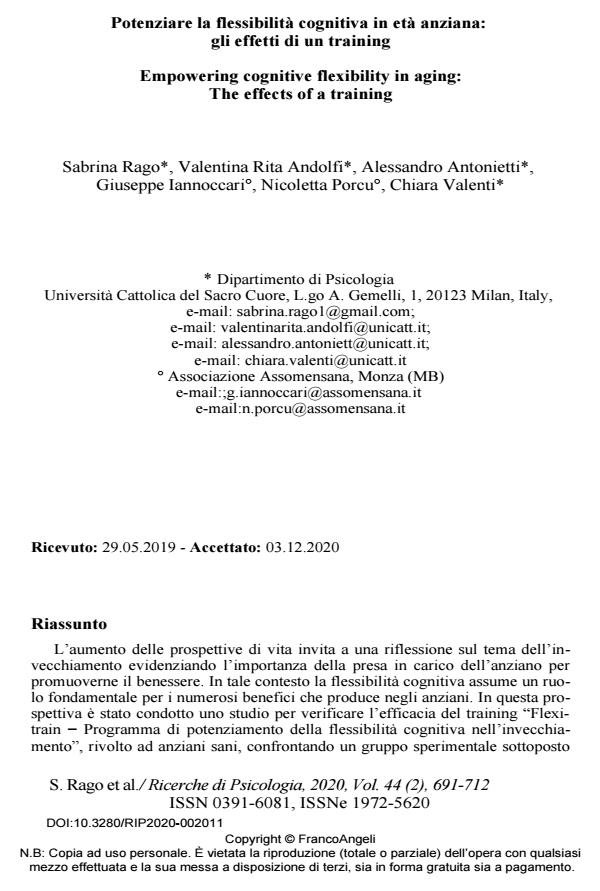Potenziare la flessibilità cognitiva in età anziana: gli effetti di un training
Titolo Rivista RICERCHE DI PSICOLOGIA
Autori/Curatori Sabrina Rago, Valentina Rita Andolfi, Alessandro Antonietti, Giuseppe Iannoccari, Nicoletta Porcu, Chiara Valenti
Anno di pubblicazione 2020 Fascicolo 2020/2
Lingua Italiano Numero pagine 22 P. 691-712 Dimensione file 267 KB
DOI 10.3280/RIP2020-002011
Il DOI è il codice a barre della proprietà intellettuale: per saperne di più
clicca qui
Qui sotto puoi vedere in anteprima la prima pagina di questo articolo.
Se questo articolo ti interessa, lo puoi acquistare (e scaricare in formato pdf) seguendo le facili indicazioni per acquistare il download credit. Acquista Download Credits per scaricare questo Articolo in formato PDF

FrancoAngeli è membro della Publishers International Linking Association, Inc (PILA)associazione indipendente e non profit per facilitare (attraverso i servizi tecnologici implementati da CrossRef.org) l’accesso degli studiosi ai contenuti digitali nelle pubblicazioni professionali e scientifiche
L’aumento delle prospettive di vita invita a una riflessione sul tema dell’invecchiamento evidenziando l’importanza della presa in carico dell’anziano per promuoverne il benessere. In tale contesto la flessibilità cognitiva assume un ruolo fondamentale per i numerosi benefici che produce negli an-ziani. In questa prospettiva è stato condotto uno studio per verificare l’efficacia del training "Flexi-train - Programma di potenziamento della flessibilità cognitiva nell’invecchiamento", rivolto ad anziani sani, confrontando un gruppo sperimentale sottoposto all’intervento di potenziamento con un gruppo di controllo. I risultati mostrano che nel post-test i soggetti del gruppo sperimentale hanno ottenuto punteggi maggiori di flessibilità cognitiva rispetto al gruppo di controllo. Inoltre emerge una maggiore capacità riflessiva e una consapevolezza critica più eleva-ta nel primo gruppo rispetto al secondo. Il training appare essere uno strumento adeguato per sviluppare nell’anziano strategie cognitive e riflessioni sul funzio-namento mentale utili all’adattamento nella vita quotidiana.
Parole chiave:Invecchiamento di successo, flessibilità cognitiva, creatività, potenziamento, benessere.
- Creativity in older people’s life: From leisure activities to ecological training programs [A commentary on ‘Creativity, aging, context, and culture’ by Adams-Price andMorse (2024)] Alessandro Antonietti, Laura Colautti, in Possibility Studies & Society 27538699251355537/2025
DOI: 10.1177/27538699251355537
Sabrina Rago, Valentina Rita Andolfi, Alessandro Antonietti, Giuseppe Iannoccari, Nicoletta Porcu, Chiara Valenti, Potenziare la flessibilità cognitiva in età anziana: gli effetti di un training in "RICERCHE DI PSICOLOGIA " 2/2020, pp 691-712, DOI: 10.3280/RIP2020-002011